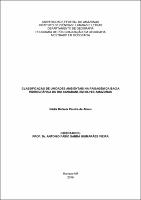| ???jsp.display-item.social.title??? |


|
Please use this identifier to cite or link to this item:
https://tede.ufam.edu.br/handle/tede/5182| ???metadata.dc.type???: | Dissertação |
| Title: | Classificação de Unidades Ambientais na paisagem da bacia hidrográfica do Rio Sanabani, em Silves-Amazonas |
| ???metadata.dc.creator???: | Abreu, Nádia Rafaela Pereira de  |
| ???metadata.dc.contributor.advisor1???: | Vieira, Antonio Fábio Sabbá Guimarães |
| ???metadata.dc.description.resumo???: | A presente pesquisa buscou definir unidades ambientais na bacia do rio Sanabani, em Silves Amazonas. A classificação teve o solo como elemento homogeneizador da unidade. Os procedimentos metodológicos utilizados passaram por três fases, na qual a primeira foi o trabalho em gabinete que consistiu no levantamento teórico e sistematização dos dados obtidos; a segunda fase foi em campo, a partir de obtenção de amostras de solo e quantificação da vegetação, a terceira foi em laboratório, aplicando análise química e física do solo obtido. Ao final dos procedimentos metodológicos elaboraram-se cartas-imagens espacializando as unidades ambientais e nivelando-as quanto aos graus de sustentabilidade (ambiente sustentável, ambiente médio e ambiente insustentável). A pesquisa teve como referencial a teoria geral dos sistemas (BERTALANFY, 2015), teoria da complexidade ambiental (MORIN, 2010), classificação de unidades pelos métodos de Bertrand (1971) e Tricart (1973), Sotchava (1977), no qual utilizou conceitos padronizados por cada autor adequando a área de estudo. A bacia hidrografia Sanabani encontra-se ‘’cortada’’ pelas estradas AM-330 e AM-363. O entorno dessas estradas estão com o solo desprotegido, movimentos de massa e com incisões erosivas, no total de 22 voçorocas. As margens do rio Sanabani não possuem vegetação, sendo uma das áreas mais vulneráveis da bacia Sanabani. No geral, identificaram-se dois tipos de solo, o Latossolo Amarelo e o Espodossolo, classificando, duas unidades ambientais. A bacia hidrográfica Sanabani encontra-se em três níveis de sustentabilidade, que são: Ambiente sustentável, ambiente médio e ambiente insustentável, representados, na presente pesquisa, por: EN+S=Pe, em que EN - refere-se aos elementos naturais; S - refere-se à sociedade; Pe - refere-se à paisagem equilibrada, sendo um pressuposto teórico fundamentado nas idéias de Bertrand (1971), com o ser humano inserido no sistema natural e à fórmula EN+S²=Pi, em que EN – refere-se aos elementos naturais; S² - refere-se a intervenções da sociedade que modificam o sistema natural; Pi – refere-se à paisagem instável, sendo um pressuposto com bases na teoria de Sotchava (1977), no qual o ser humano está fora do sistema natural, uma vez que descaracterizou a paisagem, tornando-se um agente externo ao ambiente. |
| Abstract: | The present study aimed to define the Sanabani basin’s environmental units, located at Silves – Amazonas. The soil was the key element to delimit this unit. The methodological procedures use are divided in three steps: first -literature revision and systematization of data; second – work field, where collected soil samples, quantification of the local vegetation; third – laboratorial analyses, physical and chemical soil analyses. At the end of the methodological procedure were elaborated chart-maps spatializing the environmental units and dividing them by levels considering the sustainability degrees (sustainable environment, medium environment and unsustainable environment). The present dissertation have as referential the System General Theory, (BERTALANFY, 2015), Complexity Theory (MORIN, 2010), Units classification by the methods of Bertrand (1971) and Tricart (1973), Sotchava (1977), where were used concepts adapted from the each author to the study area. The Sanabani watershed is cross by the roads AM-330 and AM-363. The surroundings of these roads present unprotected soil, landslides and erosion features, a total of 22 gullies. The border the river Sanabani River do not present vegetation, being the most vulnerable areas at the Sanabani Watershed. In general, it’s identified two types of soil, the yellow oxisoils and the Spodols, thus classifying two different environmental units. The Sanabani watershed presents three degree of sustainability:sustainable environment, medium environment and unsustainable environment, represented, in this research, by: EN+S=Pe, whereEN –is referred to the natural elements;S –to society; Pe–is referred to the landscape in equilibrium,being a theoretical presupposed based on the ideas of Bertrand (1971), considering the human being insert in the natural system and to the formula EN+S²=Pi,where theEN – referees to the natural elements; S² - referrers to the intervention developed by the society which changes the natural system; Pi –means the instable landscape, being the presupposed at the Sotchava (1977) theory, where the human being is outside the natural system, once the landscape is uncharacterized, becoming external agent to the environment. |
| Keywords: | Unidades Ambientais Rio Sanabani Environmental Unit |
| ???metadata.dc.subject.cnpq???: | CIÊNCIAS HUMANAS: GEOGRAFIA |
| Language: | por |
| ???metadata.dc.publisher.country???: | Brasil |
| Publisher: | Universidade Federal do Amazonas |
| ???metadata.dc.publisher.initials???: | UFAM |
| ???metadata.dc.publisher.department???: | Instituto de Ciências Humanas e Letras |
| ???metadata.dc.publisher.program???: | Programa de Pós-graduação em Geografia |
| Citation: | ABREU, Nádia Rafaela Pereira de. Classificação de Unidades Ambientais na paisagem da bacia hidrográfica do Rio Sanabani, em Silves-Amazonas. 2016. 106 f. Dissertação (Mestrado em Geografia) - Universidade Federal do Amazonas, Manaus , 2016. |
| ???metadata.dc.rights???: | Acesso Aberto |
| ???metadata.dc.rights.uri???: | http://creativecommons.org/licenses/by/4.0/ |
| URI: | http://tede.ufam.edu.br/handle/tede/5182 |
| Issue Date: | 28-Apr-2016 |
| Appears in Collections: | Mestrado em Geografia |
Files in This Item:
| File | Description | Size | Format | |
|---|---|---|---|---|
| Dissertação - Nadia Rafaela Pereira de Abreu.pdf | 4.4 MB | Adobe PDF |  Download/Open Preview |
This item is licensed under a Creative Commons License





